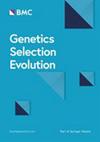Italian local chicken breeds: a comparative analysis of biodiversity on a global scale
IF 3.1
1区 农林科学
Q1 AGRICULTURE, DAIRY & ANIMAL SCIENCE
引用次数: 0
Abstract
Chickens, domesticated around 3500 years ago, are crucial in global agriculture, resulting in hundreds of breeds worldwide. In Europe, intensive breeding has led to the creation of numerous distinct commercial lines at the expense of local breeds. As a result, local breeds, which are not subject to rigorous selective practices, face higher risks of genetic problems due to a narrower genetic base. Modern genotyping and bioinformatic approaches allow detailed genetic analysis. This study offers a comprehensive genetic overview of Italian chicken biodiversity compared to global breeds, emphasizing the importance of preserving local genetic diversity. Hundred and ninety-two chicken breeds from various countries were analyzed, with Italian breeds being highly represented. Genetic relationships showed that Italian breeds clustered with some European, African, and Asian breeds. The ADMIXTURE analysis identified 25 distinct populations and highlighted genetic similarities of certain Italian breeds with German, French, and Swiss ones. Genetic diversity was high in African and some Asian and European breeds, with Italian breeds exhibiting moderate diversity and variability. The TreeMix analysis revealed significant migration events and evolutionary clustering. The Italian breeds had close genetic ties and some highlighted evidence of genetic introgression from common ancestors. Italian chicken breeds have significant genetic relationships with European, Asian, and African breeds, reflecting historical trade and breeding exchanges. Southern Italian breeds form a distinct genetic group, highlighting regional uniqueness. Overall, the research points out the need for conservation strategies to preserve genetic diversity and account for historical and contemporary gene flows, ensuring the sustainability of Italian chicken biodiversity in the face of environmental and agricultural challenges.意大利地方鸡品种:全球范围内生物多样性的比较分析
鸡大约在3500年前被驯化,在全球农业中起着至关重要的作用,在世界范围内产生了数百个品种。在欧洲,集约化育种以牺牲当地品种为代价,创造了许多独特的商业品种。因此,由于遗传基础较窄,不受严格选择实践约束的地方品种面临较高的遗传问题风险。现代基因分型和生物信息学方法允许详细的遗传分析。本研究提供了意大利鸡肉生物多样性与全球品种相比的全面遗传概况,强调了保护当地遗传多样性的重要性。对来自不同国家的192种鸡进行了分析,其中意大利品种的代表性很强。遗传关系表明意大利品种与一些欧洲、非洲和亚洲品种聚集在一起。admix分析确定了25个不同的种群,并强调了某些意大利品种与德国、法国和瑞士品种的遗传相似性。非洲和一些亚洲和欧洲品种的遗传多样性很高,意大利品种表现出适度的多样性和变异性。TreeMix分析揭示了显著的迁移事件和进化聚类。意大利品种有密切的遗传联系,一些突出的证据表明来自共同祖先的遗传渗入。意大利的鸡品种与欧洲、亚洲和非洲的鸡品种有着重要的遗传关系,这反映了历史上的贸易和养殖交流。意大利南部品种形成了一个独特的遗传群体,突出了区域独特性。总体而言,该研究指出,需要采取保护策略来保护遗传多样性,并考虑历史和当代基因流动,以确保意大利鸡的生物多样性在面临环境和农业挑战时的可持续性。
本文章由计算机程序翻译,如有差异,请以英文原文为准。
求助全文
约1分钟内获得全文
求助全文
来源期刊

Genetics Selection Evolution
生物-奶制品与动物科学
CiteScore
6.50
自引率
9.80%
发文量
74
审稿时长
1 months
期刊介绍:
Genetics Selection Evolution invites basic, applied and methodological content that will aid the current understanding and the utilization of genetic variability in domestic animal species. Although the focus is on domestic animal species, research on other species is invited if it contributes to the understanding of the use of genetic variability in domestic animals. Genetics Selection Evolution publishes results from all levels of study, from the gene to the quantitative trait, from the individual to the population, the breed or the species. Contributions concerning both the biological approach, from molecular genetics to quantitative genetics, as well as the mathematical approach, from population genetics to statistics, are welcome. Specific areas of interest include but are not limited to: gene and QTL identification, mapping and characterization, analysis of new phenotypes, high-throughput SNP data analysis, functional genomics, cytogenetics, genetic diversity of populations and breeds, genetic evaluation, applied and experimental selection, genomic selection, selection efficiency, and statistical methodology for the genetic analysis of phenotypes with quantitative and mixed inheritance.
 求助内容:
求助内容: 应助结果提醒方式:
应助结果提醒方式:


